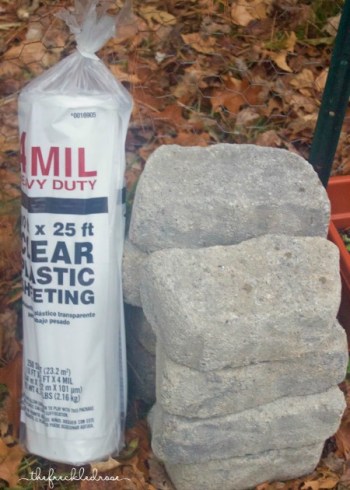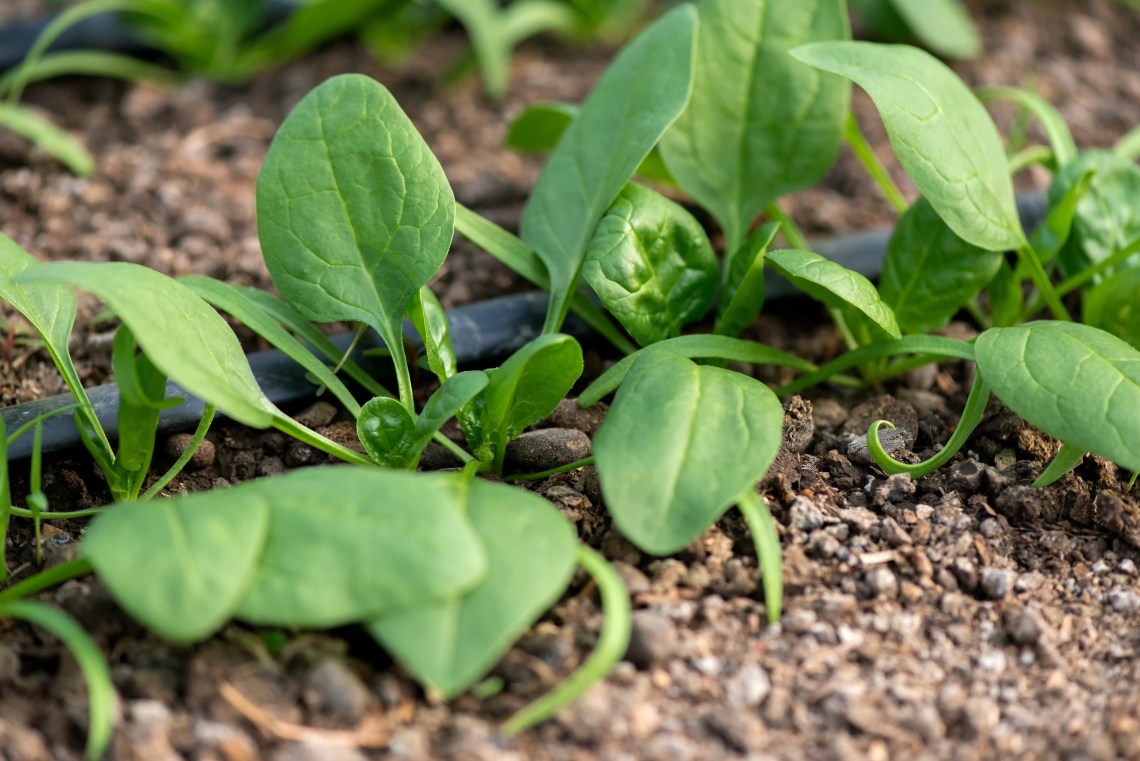
Here in zone 6a New England, the growing season is so short. By the end of November, trees have shed their leaves and plants have gone into hibernation mode. When the ground starts to freeze and the days become shorter, us gardeners turn to houseplants and planning next year's harvest.
Although that can be very enjoyable, I really wanted to try something new! I decided to try extending my growing season deep into the chilliest months. I grow vegetables and herbs during the summertime in a raised garden bed.

Adding a hoop house to this already built bed is rather inexpensive and relatively easy to maintain.
I spent some time doing research online and looking at some helpful books, and then dove right in! Although I am unsure at the moment of the amount of growing success I will have, I've decided to enjoy it and just give it a try.
This is the year for trial and error with a modest budget. If all I gain from this is knowledge, I will still be satisfied! Most of the materials and tools I used to build my winter garden can be found at East Coast Hardware.
Click here to buy supplies for your own winter garden

Building A Hoop House
My raised garden bed is 11 feet long and 5 feet wide. The hoop house consists of four 10 foot 1/2-inch PVC conduit. I purchased these at my local hardware store for $1.59 a piece.
PVC conduit is flexible and sturdy enough to prevent it from collapsing under the snow. Luckily, I did not have to cut or change the original size in any way. I then bent them into the position and shape I wanted. After adding the PVC conduit, I prepped my bed by adding new soil along with some fertilizer.

PVC Conduit Total Cost=$6.36

 When prepping my raised garden bed, I added some fresh new soil and some Happy Frog Fruit & Flower Fertilizer.
When prepping my raised garden bed, I added some fresh new soil and some Happy Frog Fruit & Flower Fertilizer.
This mix contains bat guano, bone meal, kelp meal and feather meal! I want to give my seeds the best chance to sprout into strong plants while fighting against colder conditions.
I'm hoping with extra care and nutrition, it will give them that extra push. The wonderful thing about fertilizer is one bag can last you up to an entire year! It lasts a long time when you have a small sized garden!
Fertilizer Cost=$12.50

 I covered my newly built hoop house and baby seedlings in my raised garden bed with 4 MIL 10ft x 25ft clear plastic. I purchased this at my local hardware store for $11.47.
I covered my newly built hoop house and baby seedlings in my raised garden bed with 4 MIL 10ft x 25ft clear plastic. I purchased this at my local hardware store for $11.47.
I did some adjusting and cutting to size so it fits snugly. I also purchased eight of these stone blocks for $2.28 a piece to hold it down and keep it from blowing away.
Nobody likes a rogue giant plastic tarp rolling through the neighborhood! I also have some duct tape on hand for any holes or rips that may occur during the harsh winter months. I may purchase an extra covering to have on hand.
Plastic Sheeting Cost=$11.47
Stone Block Total Cost=$18.24

Under The Hoop


Here is the winter garden bed with its new plastic covering. I will be closely monitoring the temps inside for the first week to see how warm it gets.
The weather really fluctuates here in New England. One day it's 30°F the next it's back up to 60°F. I'm using an outdoor thermometer to keep an eye on the temperature inside my hoop house.
Thermometer Cost=$5.98
I find the thermometer very helpful so far, and I am hoping my seeds sprout into vigorous, full grown plants.

So here is what it looks like on the inside of my winter garden hoop house. I planted many different greens, broccoli, cabbage, carrots, garlic, kale, leeks, onions, peas, radishes & turnips.

I found a great selection of cold tolerant vegetable seeds over at Baker Creek Heirloom Seed Company. It's also good that most of the vegetables I have chosen are shade tolerant. I know the sun isn't as prominent and strong during the winter months.

 Thanks to so many great suggestions from gardeners on Facebook and Twitter, I decided to add a floating garden blanket for extra protection. I purchased these Gardeneer by Dalen Harvest Guards 40 inch by 50 foot for $9.99 a piece.
Thanks to so many great suggestions from gardeners on Facebook and Twitter, I decided to add a floating garden blanket for extra protection. I purchased these Gardeneer by Dalen Harvest Guards 40 inch by 50 foot for $9.99 a piece.
I am only using one, but I purchased an extra to have on hand. These covers trap heat and moisture as well as protecting against frost. Since they are also good for keeping crops protected from insects and pests, I will be using these over my garden bed during the summer months as well. I can't wait to see if this extra layer of protection helps!
Garden Crop Cover Total=$19.98

Here are my seeds staying toasty under their new garden blanket! I have been monitoring my seeds growth, and now that I see some starting to sprout, I will be mulching in my bed this upcoming weekend. After I mulch it in with leaves from my yard, I will cover the mulching with the garden blanket again.

Total Winter Garden Cost=$64.54

Winter Crops
There are so many garden crops that grow well during the winter months. I took my time researching which vegetables thrive in the cold, and narrowed it down to a select group I was interested in.
Over on Plantsmap.com, I added a winter garden collection. Collections on Plantsmap allows you to keep track of the names of the plants you are growing, add photographs and also gives you a way to document and detail your growing experience.

If you wan't to see a full list of what I am growing, check out my collection here. These are some of the greens I have picked to grow in my vegetable garden.

Arugula is one of my favorite greens with a spicy flavor. Fordhook Giant Swiss Chard has large, crinkled leaves with ivory colored stems.

Amsterdam Prickly Seeded spinach is noted for being the hardiest of all the varieties. The sturdy plants have flat, tender leaves with red tinged stalks. All of these greens are known to do well in colder temperatures.

Above are more greens otherwise known as "other greens" I am growing in my winter garden. Morris Heading Collards have dark green leaves and is a variety that is slow to bolt.

Corn Salad produces flavorful, deep green leaves & is fairly cold-hardy. Miner's Lettuce has a spinach like texture with mild tasting leaves.

Learning & Growing
Building a winter garden has been a great learning experience for me. I've received so many helpful suggestions to make it even more successful! I am definitely going to be mulching it in to see if that helps trap in heat.
I also want add mulch to help with the moisture level. Since it can get really humid under the tarp, with less sun in the winter it is the perfect environment for mold to grow. I'm hoping to defend against that by not overwatering and also adding dry material to the soil.

I am going to be adding one more piece of PVC conduit across the top to add more support and to help prevent problems with the future piles of heavy snow. When it does snow, I will be going out regularly to clean off the top to prevent it from collapsing under the strain of the weight.
I have also heard that adding Christmas lights to the inside of the hoop house can prevent plants from freezing, so I may give that a try.
Right now I am reading The Year-Round Vegetable Gardener by Niki Jabbour. It is such a great book full of helpful content!
Garden friends have suggested I look into reading The Winter Harvest Handbook by Eliot Coleman, who just happens to be from New England as well! I'm hoping to purchase this soon for some helpful reading material.

Do you extend your outdoor growing season into the fall and winter months? What are some tips you have heard or have tried to ward off frost and a hard freeze? Please share with me in the comment section below.
Although I don't mind if Snow Miser brings us a white Christmas, I'm trying to prevent his friend Jack Frost from getting anywhere near my precious veggies. Check back soon to see update from my endeavors into the exciting world of winter gardening!

If you enjoyed reading this post, you might also like these:
• Vegetables to Plant in the Winter Garden






71 Comments
Sheena
April 6, 2016 at 12:56 pmLove the idea of a hoop house! I may try this next winter… love ways to lengthen the growing season!
malena penney
April 5, 2016 at 7:52 pmYou are such an inspiration! I need to do this..we are just starting to get some icy mornings here in New Zealand…
Renee Fuller
January 6, 2016 at 7:08 pmGreat post on winter gardening.
Ness
December 17, 2015 at 6:54 amWe’ve just got an allotment so everything is completely new to us. I like the idea of using covers. Next on our plans I think!
Floral Fridays
December 17, 2015 at 3:17 amWith the right preparation and care, even a tiny plot can be very productive, Angie.
Thank you for taking part in Floral Friday Fotos meme.
Amanda
December 16, 2015 at 4:34 pmFingers crossed, sounds like you’ve done your homework! I think I need those blanket things for a few of our plants, I might just invest in a few.
Sharleen
December 15, 2015 at 7:34 pmVery interesting! Thanks for linking up to Home Matters Party. #HomeMattersParty http://cu-rio.net/home-matters-linky-party-66/
Annie
December 15, 2015 at 4:52 pmIt worked out so much cheaper than I would have though – what a bargain! Good luck with your growing.
Thanks for joining in again lovely x
Kathryn
December 15, 2015 at 12:45 amThis is our first year trying a hoop house. I’ll have to give the blanket and the lights a try. Nice ideas.
Margaret
December 14, 2015 at 7:40 pmAngie, what do you do if the inside of your little hoop house gets too cold?
Also, when you water does it not just freeze??
Neesie
December 14, 2015 at 5:07 pmI think this is exactly what I need to do in my garden. The growing season is quite short here too in Bonnie Scotland. I’m going back to reread your post and make notes.
Thanks for sharing ;D
Lyn (aka) The Travelling Lindfields
December 14, 2015 at 4:35 pmWhere I live (Sydney, Australia) it is summer and the problem is not keeping the vegetables warm but keeping the possums and bandicoots from eating them. Your hoop house, with a couple of alterations, looks perfect – I am just about at my wits end trying to keep my veggies from being eaten by the wildlife before they are ready to pick.
Katey
December 13, 2015 at 10:39 pmThank you so much for stopping by the Homestead Blog Hop!!
Hannah@SeeingtheLovely
December 12, 2015 at 7:56 pmWhat a great idea! I’m fairly new to gardening, but I will definitely have to keep these suggestions in mind this coming winter!
Coombe Mill - Fiona
December 12, 2015 at 7:43 pmI hope your winter garden produces some great results, it looks so well thought out #HDYGG